Latest from C&E/NetDev Ops/GIS/Open-Source Networks
Using the Past to Accelerate the Future —
It has been a while, but it’s good to be back.
I thought that I pretty much covered every aspect of OSP Network Transformation (NT) in my columns dating back to 2018 — at least at a high level — so I decided it was probably time to put away the Underwood. (I really don’t use a typewriter, but I thought it sounded more poetic than "the Mac".)
Then, 2020 hit. One positive takeaway from the last 12 months was the ample time it gave me to reflect on things a bit. I was about 4 months into my self-imposed exile when I realized everything I talked about regarding NT was forward thinking (i.e., moving people to fiber). But what about the past?
After reading many of Don McCarty’s columns on Cable Fault Locating and Repair (For example, see ISE’s June and July 2020 issues.), it dawned on me that I was ignoring the core infrastructure that has served (and in some places continues to serve) the industry well for more than a century. What are we to do with all of the copper that sits out there? You can’t just let it sit there forever, taking up space in conduits and on poles (and on asset sheets).
Sadly, like many relics, copper has been pushed to the back of the pile in many locations, taking up space in the corner like your Palm Pilot, Discman, and the aforementioned Underwood. They were all state-of-the-art during their heyday, but essentially irrelevant today if newer technology is available.
Luckily, we can easily tidy up our lives by recycling these relatively small items, but we cannot do that with copper cable. Or can we?
InvisiLight® Solution for Deploying Fiber
April 2, 2022Go to Market Faster. Speed up Network Deployment
April 2, 2022Episode 10: Fiber Optic Closure Specs Explained…
April 1, 2022Food for Thought from Our 2022 ICT Visionaries
April 1, 2022Mining for the Future?
One of the things we focused on a few years back at work was the notion of cable mining — the identification, purification, and decommissioning, of assets no longer in use. This proved to be a valuable way to free up some needed real estate (like ducts and pole space) and potentially make a few bucks along the way. However, we soon learned that nothing is easy. The process proved to be fairly cumbersome and prone to service interruptions if we weren’t careful. More importantly, if copper pricing was a bit off, the entire effort wouldn’t be worth all of the required grunt work.
Since that was a number of years ago, I wondered if the situation has gotten any better in the last few years.
To get a sense of what we could do to improve the process in 2021, I reached out to Al Purdy, CEO of a company called Green Planet 21. I had a bit of experience with Al in the past, so he was a logical person to ask about the status of copper mining.
Al’s passion is to make the mining process efficient and profitable for everyone while actually improving the environment. In addition to their aforementioned telecom experience, Al and his team are committed to doing what’s right for our planet by recycling everything from cardboard (we had a ton of that in our garages as we deployed ONTs, routers, etc.) to plastics and organic waste. The goal is to utilize everything they touch, holding true to their Zero Landfill Practices.
Al explained how they have been working with telecom companies across the globe to identify target assets for decommissioning and recycling. He found that while companies usually do a great job of focusing on the future, they often do not pay much attention to the equipment that is rarely, if ever, used to serve end users. "The future is exciting, the past not so much," observed Al.
When it comes to copper mining, Al recommends a detailed, process-driven approach when creating A Service Provider’s Copper Recycling / Decommissioning Program.
Critical steps include:
Step #1: Determine the best location to start your program.
Like any other journey, the most important step is the first. Prior to doing any of the physical work, you and your copper-mining partner should work to determine the appropriate location, time frame, and allocation, of all proceeds.
As with any partnering relationship, the goal is that everyone walks away with a win. If you fail to execute this first step properly, someone will likely walk away unhappy.
Step #2: Set your objectives with reality, not perfection, in mind.
Do you want to completely remove facilities and decommission a serving office? Or do you want to simply clean up a few manholes and cable vaults? This is where the vendor’s/partner’s experience pays off. Engage a partner you can trust to help consider the big picture as well as execute the program itself.
Don’t fall victim to vendors promising a big return for little effort. Focus on partners with a proven track record.
Step #3: Establish key timeline and milestones.
Don’t rush into things because you never want to disrupt your customers’ services. The ideal partner will scour any and all available records to determine the scope of the project, including the number of cables, their size (gauge, length, etc.) and the potential for decommissioning.
Doing your homework up front will save a lot of grief in the long run.
Step #4: Make sure the process is transparent, open for team feedback, and built for tracking each step of the way to ensure that every ounce of copper is captured.
Once decommissioning work is complete and unused cables removed, ensure that everything is appropriately logged in an inventory tracking system prior to recycling/sale. This approach not only ensures everyone is aligned, it helps to identify the source of any downstream issues that could surface.
If market rates are too low, a good partner will hold onto the copper until the market improves, so be sure to ask if they monitor markets across the globe. Remember, in the end the proceeds from the reclaimed copper and equipment must not only cover the cost of the effort, but they also have to provide a positive return to you as the service provider.
Step #5: Create a collaborative process that involves available provider employees to help verify every cable pair.
Employees can help consolidate working pairs into the best cable in a way that helps improve customer service and reduces maintenance costs. This step of the process is still somewhat labor-intensive, because you want to make sure that no customer is harmed during the recovery process.
Feedback From the Right Sources
I think these initial steps are very sound, but I also wondered if there was a way to utilize technology to simplify things and reduce associated costs. To help figure this out I reached out to Bill Doyle, CEO of Dexter (who helped with an earlier column about systems and technical debt). I consider Bill to be a genius when it comes to leveraging technology to reduce labor costs and ensure quality and consistency. He’s done things like this for me in the past, so I thought it would be a chip shot for him.
After sharing the process with Bill, he thought there was a definite opportunity to automatically identify low fill equipment and facilities in systems like TIRKS and LFACS using A.I. Bill said a system like this could help identify high value cables in various engineering databases in a cost-effective manner. Of course, there would still be a need for verification, but the financials would improve for everyone with automation.
Based on talking with an expert who had extensive field experience and another with a track record of automating things, I started to think I was onto something that could prove effective in terms of network transformation. However, I knew that I still needed to explore whether this concept and process could really benefit the telecom/ICT industry.
Realizing that I needed to see if all of this worked in the real world, I reached out to Julie Murtagh, SVP of Frontier’s east region. Julie and I go way back; I consider her to be a leader that gets things done.
Julie was intrigued. She shared that, "We have quite a bit of copper in my footprint and I think it would be great to use the idle assets to help improve service for my customers. Those types of assets are of no help to anyone if they are just sitting there taking up valuable space." She went on to say that she is always interested in hearing from vendors who can help identify low-hanging fruit when it comes to scouring a provider’s existing infrastructure for retirement candidates.
What’s Next?
So a world-class recycler, a technical guru, and an outstanding operations leader walk into a bar… what happens next?
Stay tuned.
Like this Article?
Subscribe to ISE magazine and start receiving your FREE monthly copy today!
References and Notes
Green Planet 21. https://greenplanet21.com/
"Technical Debt Remediation." By Tom Maguire. May 2019, ISE magazine. Dexter CEO Bill Doyle quoted. https://isemag.com/2019/05/telecom-network-transformation-technical-debt/
"Cable Fault Locating and Repair, Part 1, Short-Term and Long-Term Approaches." By Don McCarty. June 2020, ISE magazine. https://isemag.com/2020/06/telecom-cable-fault-locating-and-repair-part1/
"Cable Fault Locating and Repair, Part 2. Identifying a Faulted Pair." By Don McCarty. July 2020, ISE magazine. https://isemag.com/2020/07/telecom-part-2-identifying-a-faulted-pair/









